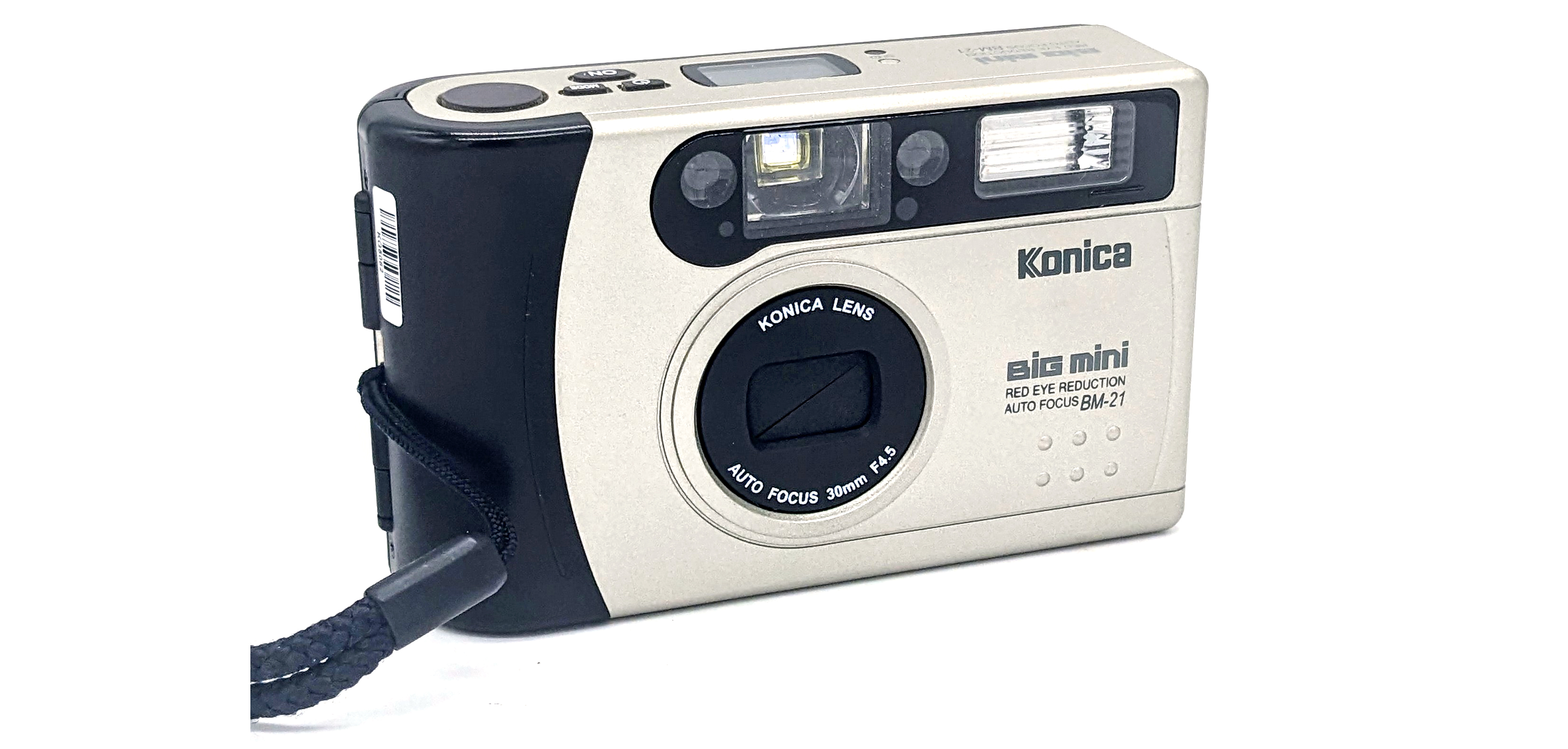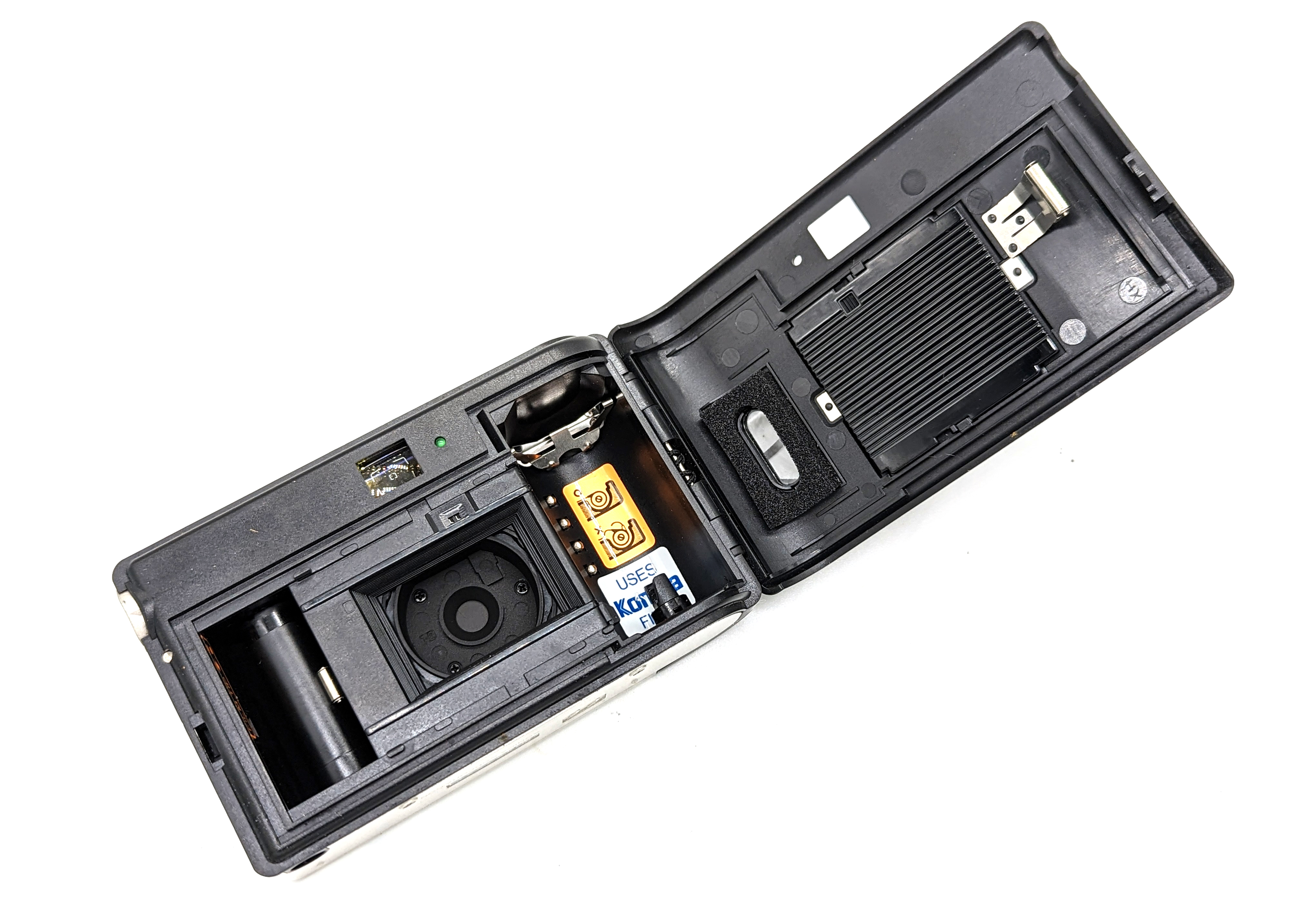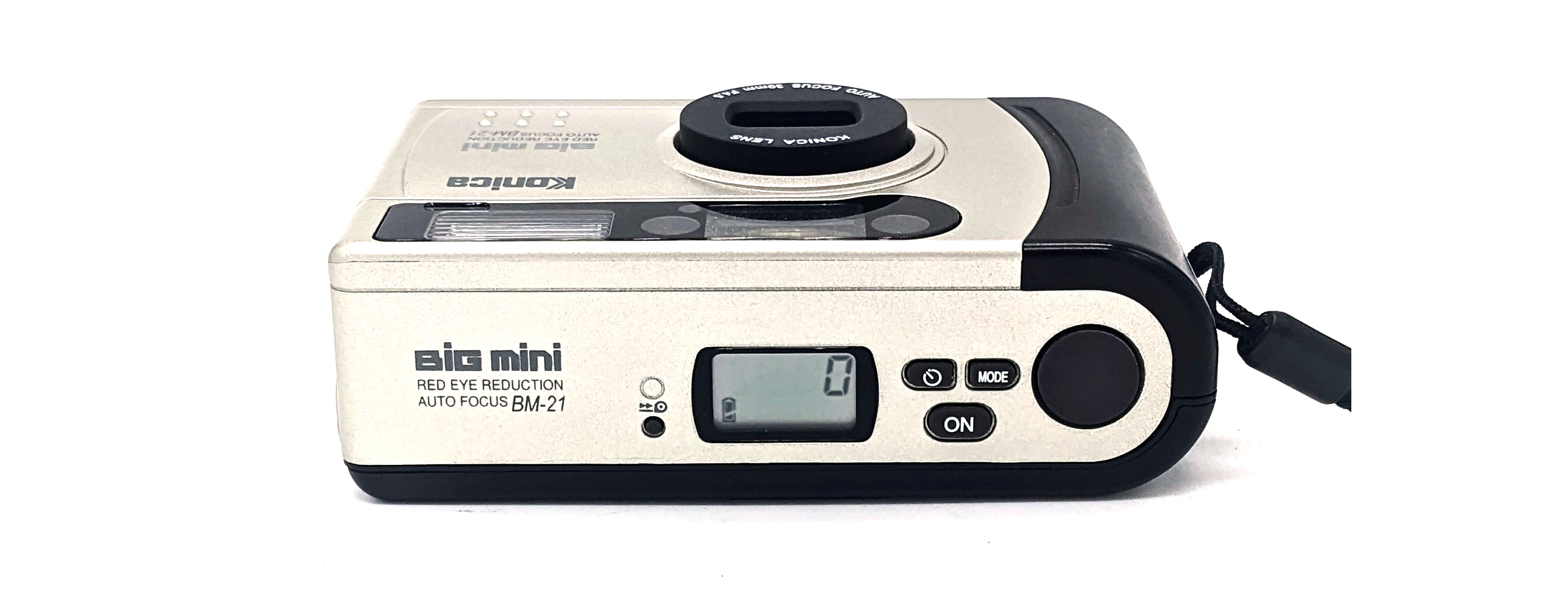
The Big Mini 21 is a rather obscure point-and-shoot camera with a fixed 30mm f/4.5 lens produced by Konica around 1994. Sharing nothing physically in common with any other Konica product of the 1990s, and with the manual so far MIA on the internet, the BM-21 remains somewhat of a mystery in terms of functionality. Does the entirely automatic BM-21 take good photos? Is Konica’s 30mm lens any good? After some testing, and unfortunately, it seems that there is nothing particularly special about the performance and functionality of the BM-21 (other than its size); and it is about par for the course for mid-range consumer point-and-shoots of the mid-1990s.
Upon shutting down its SLR business in 1987, Konica shifted its focus to the continued production of compact 35mm point-and-shoot cameras. During 1989, Konica introduced the “A4,” its next generation autofocus point-and-shoot that provided the platform for the successful “Big Mini” camera line of the 1990s. The next year, Konica launched the first “true” Big Mini model, the BM-201. During 1993, Konica introduced the iconic “Hexar AF,” perhaps the most capable autofocus point and shoot ever produced. Konica’s 1990s higher-end models like the BM-301 and the Big Mini F are well-known and have been extensively reviewed.
With a design wholly distinct from the rest of the Big Mini line, the BM-21 offered the usual consumer features but with a wider 30mm f/4.5 lens. It seems that the BM-21 appeared and then disappeared rather quickly, with the initial batches apparently having some mechanical and/or electrical gremlins that were eventually worked out in later production. It is also not clear if the BM-21 was ever officially offered for sale in North America as I cannot find it advertised in the media of the time. Although BM-21s do occasionally pop up for sale, it seems that most examples reside outside of North America. In 1996, Konica introduced the apparent successor to the BM-21, the “VX BM-701” (assembled in China), a more conventionally-styled point and shoot with a fixed 29mm f/4 lens (most likely the same lens as found in the BM-21). There were plenty of similar contemporary consumer cameras with fixed 29-30mm lenses, like the Nikon Fun Touch 5, the Pentax PC-55, the Ricoh R1e, and others.
The BM-21 is truly a camera that can fit in any pocket, purse, or bag. With no manual out there so far to guide us, let’s try to figure out how it works.
Specifications
| Introduction | 1994 |
| Weight | 155g |
| Dimensions | 100 x 63 x 32mm (4 x 2.5 x 1.25 in.) |
| Lens | 30mm f/4.5 |
| Lens Design | ? |
| Shutter Speeds | ? |
| DX Coding | Yes |
| Flash Modes | 5 |
| Autofocus Lock? | ? |
| Underexposure Warning? | No |
| Battery | 1 x CR2 Lithium |

Operation
Styling: The BM-21 has a completely different design than any previous or subsequent Konica camera. It is tiny, approximately the length of playing card. In my opinion, it is one of the more attractively-designed 1990s point and shoots.
Film Loading: The BM-21 has the usual automatic load, advance, and rewind typical for point and shoots of the era. However, the film loads the opposite way from most cameras: from right to left. Not sure what that is all about. This also means that your photos will be upside down on the negatives. The film transport and rewind have the typical point and shoot high-pitched tinny sound.
30mm f/4.5 Lens: Other than the 29mm f/4 found on the later VX BM-701, it does not appear that the BM-21’s 30mm f/4.5 lens appeared on any other Konica product. While a 30mm lens can be much more versatile than a 35mm, especially for candids and travel, f/4.5 is rather slow, 2/3 of a stop slower than an f/3.5 lens. The bright side is that with a large depth of filed these types of lenses can be quite sharp and resolve wonderfully. It is unclear what the minimum focusing distance is, but I would guess somewhere between 1-1.5 meters. The 30mm lens produces photos of acceptable quality and sharpness for the 4×6 print era but do not expect “premium” point-and-shoot optical performance. The lens displays a little barrel distortion in certain conditions and sometimes vignettes a little bit.
Shooting: I think that those of us who shoot “real” cameras often expect too much from point-and-shoots. Cameras like the BM-21 were designed to be as easy as possible to use for folks who know nothing about photography. The death-knell of any photo is that it is out-of-focus because of missed focus or camera shake. Cameras like the BM-21 did their best to address this. A wider lens with a large depth-of field eliminates many focusing errors. A relatively high minimum shutter speed prevents most camera shake.
That being said, and frustratingly, the autofocus performance of the BM-21 at closer distances is hit or miss. I found that although the subject generally filled the frame at 1 meter or more, the BM-21 still managed to focus behind the subjects. The lack of: (1) feedback regarding whether a subject is too close for the minimum focusing distance (which is currently unknown); (2) confirmation of an autofocus lock (if it actually has it); and/or (3) an underexposure warning can really ruin your day. Whether the BM-21 can focus lock and how it works are really important to know, as many point-and-shoots will just focus in the center of the frame, regardless of whether the subject actually is.
It is unclear what the minimum and maximum shutter speeds are. Taking a look at the operation of the shutter, I would guesstimate that the minimum speed is about 1/15 (or even 1/8). The maximum shutter speed appears to be probably 1/250 or 1/500.
The only real control the user has over the BM-21 is the flash settings. There are five modes: (1) automatic flash operation (default); (2) red eye reduction. (3) flash always on; (4) flash always off; and (5) daylight fill flash. It is important to note that the BM-21 will always default to using the flash if it determines insufficient light exists, even in what would appear to be regular daylight conditions. Remember to turn the flash off when taking daylight photos if you do not want the flash to fire unexpectedly.
LCD: The top-mounted display only shows the frame count and the flash modes.
Viewfinder: The BM-21 has a fairly large and bright viewfinder for how diminutive the body is. There is no exposure or autofocus information in the viewfinder. There are no etched marks for any parallax correction (but a 30mm lens does not really need them).
DX Coding: The BM-21 accepts and reads DX-coded film, but it is not clear what the range is. I would guess that it would be at least 100-800. It also not clear whether the camera defaults to ASA 100 or something if a non-coded cartridge is used. There is obviously no DX override.

Conclusions
Given its unique and very cool form factor, I really, really wanted the BM-21 to be some kind of capable, reliable dark horse winner. Unfortunately, that is not the case. While its hyperfocal performance works fairly well and can produce some nice results with good color fidelity, the lack of any focus or exposure feedback drives me nuts. Full disclosure: I am generally not a fan of most point-and-shoots in any price range. I will 10/10 choose to carry a larger, heavier, and more conspicuous 35mm camera that can provide both focus and exposure feedback.
Sample Photos
Feel free to follow the Instagram account to see sample photographs from the BM-21 at the hashtag #konicabm21.